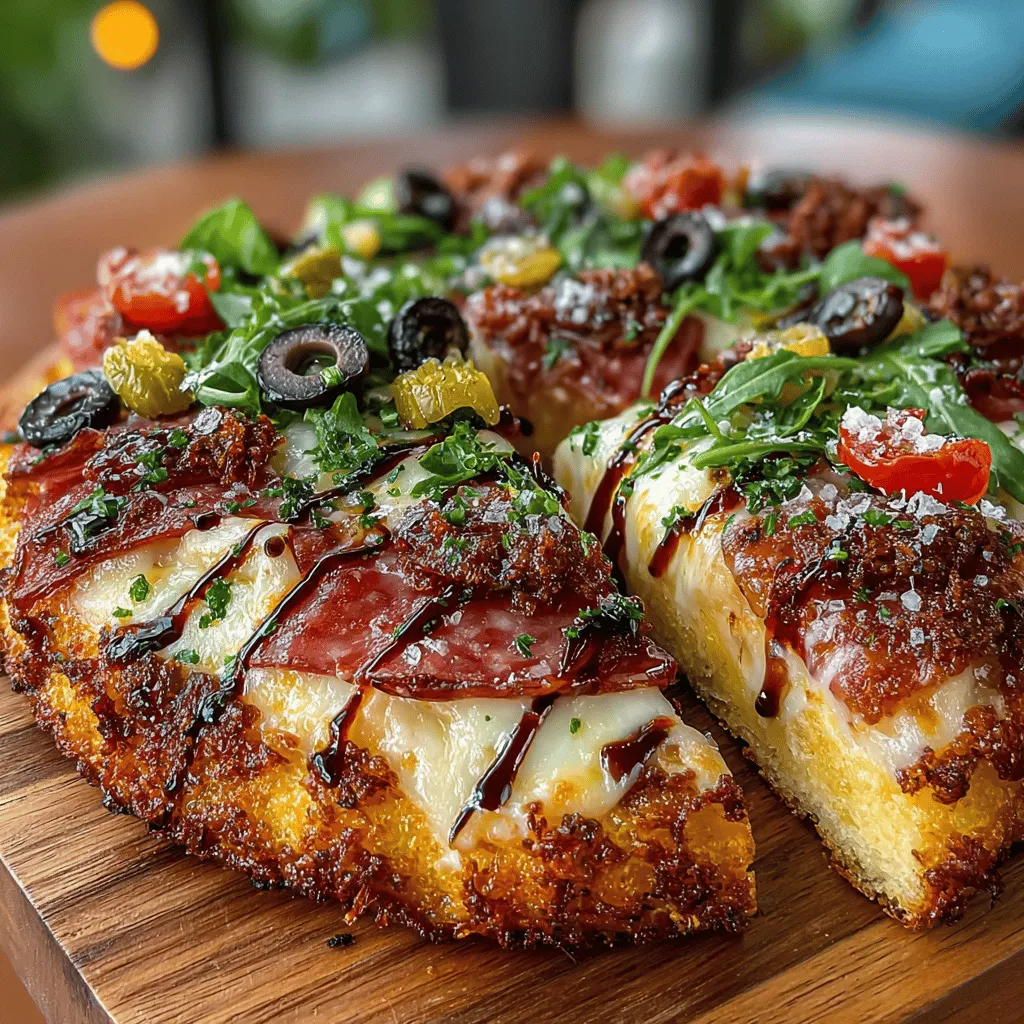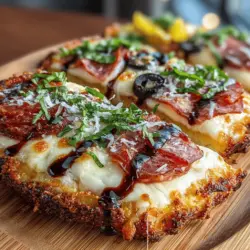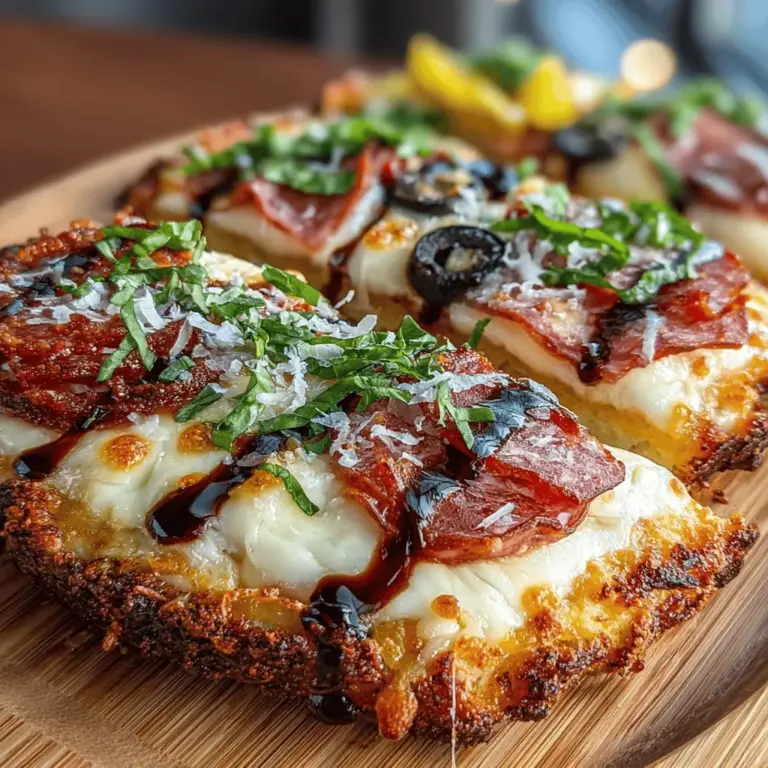Charcuterie Board Pizza Recipe
The culinary world has seen a rise in creative food pairings, and one of the most delightful trends to emerge is the charcuterie board. This concept has taken the dining experience by storm, evolving from its traditional roots into a versatile and visually stunning way to serve a variety of flavors. A charcuterie board typically features an assortment of cured meats, artisanal cheeses, pickles, nuts, and various accompaniments that invite sharing and enjoyment among friends and family. Its popularity stems from the social aspect of dining, where guests can mix and match different flavors according to their preferences, creating a personalized experience.
Now, imagine taking the essence of a charcuterie board and merging it with the beloved comfort of pizza. Enter the charcuterie board pizza—a culinary innovation that combines the best of both worlds. This recipe offers a unique and interactive dining experience that appeals to pizza lovers and charcuterie enthusiasts alike. It’s not just a meal; it’s a conversation starter, perfect for gatherings, family dinners, or a casual night at home. With its vibrant colors and diverse flavors, the charcuterie board pizza is sure to impress your guests and elevate any occasion.
Understanding Charcuterie Boards
To appreciate the charcuterie board pizza fully, it’s essential to understand the origins and elements of a traditional charcuterie board. The term “charcuterie” originates from France, where it referred to the art of preparing and assembling cured meats. Over time, this practice expanded to include various accompaniments, such as cheeses, fruits, nuts, and spreads, making it a well-rounded and appealing platter for sharing.
Typical ingredients found on a charcuterie board include a variety of cured meats like salami, prosciutto, and chorizo, which offer a spectrum of flavors from savory to spicy. Cheeses range from creamy bries to sharp cheddars, each adding a unique taste and texture. Accompaniments such as olives, pickles, and seasonal fruits provide refreshing contrasts, while nuts contribute a satisfying crunch. The beauty of a charcuterie board lies in its versatility; it can be tailored to suit different tastes and dietary preferences, making it a go-to option for any social gathering.
The social aspect of sharing a charcuterie board enhances the dining experience. Guests are encouraged to mix and match ingredients, fostering conversation and interaction as they create their ideal flavor combinations. This communal approach to food has made charcuterie boards a staple at parties, holiday gatherings, and casual get-togethers.
The Appeal of Charcuterie Board Pizza
The charcuterie board pizza takes this social dining experience a step further by providing an innovative twist on both pizza and charcuterie. This recipe invites creativity, allowing you to showcase a variety of toppings that reflect the diversity found in a traditional charcuterie board. Each bite offers a delightful combination of flavors and textures, from the crispness of the pizza crust to the richness of the cheeses and the savory notes of the meats.
One of the exciting aspects of charcuterie board pizza is the endless possibilities for flavor combinations. You can experiment with different cheeses, meats, and vegetables to create a pizza that suits your taste. For instance, the classic duo of mozzarella and provolone provides a creamy base, while the addition of pepperoni or prosciutto adds a savory punch. The incorporation of tangy pickles or zesty pepperoncini elevates the dish further, balancing the richness of the cheese and meats.
This recipe is perfect for various serving occasions, whether it’s a lively game night, a cozy family dinner, or a sophisticated gathering with friends. The charcuterie board pizza encourages sharing and interaction, making it a fantastic centerpiece for any event. Guests can customize their slices with their favorite toppings, ensuring everyone’s preferences are met.
Ingredients Breakdown
To create a delicious charcuterie board pizza, you’ll need a variety of ingredients that work harmoniously together. Here’s a detailed breakdown of each component and its role in the recipe:
Pizza Dough: The foundation of any great pizza is the dough. You can opt for store-bought dough for convenience or make your own from scratch for a more personalized touch. Homemade dough allows you to control the ingredients and achieve the perfect texture, whether you prefer a thin, crispy crust or a thicker, chewy base.
Olive Oil and Garlic: These ingredients are essential for adding flavor and richness to your pizza. A drizzle of high-quality olive oil enhances the overall taste, while minced garlic infuses the crust with aromatic goodness.
Cheese Selection: Cheese is a crucial element in the charcuterie board pizza. While mozzarella is a classic choice for its melting properties, incorporating provolone adds depth and complexity. You can also experiment with other cheeses like goat cheese or blue cheese for a unique twist.
Meats: The selection of cured meats is where the charcuterie aspect shines. Salami and prosciutto are popular choices due to their distinct flavor profiles and textures. Salami adds a spicy kick, while prosciutto offers a delicate, savory richness that pairs beautifully with the other ingredients.
Vegetables: To balance the richness of the cheese and meats, consider incorporating a variety of vegetables. Pepperoncini, pickles, and olives add a zesty, tangy element that cuts through the richness, making each bite more enjoyable.
Fresh Ingredients: To elevate the dish further, consider adding fresh ingredients like arugula and a drizzle of balsamic glaze after baking. The peppery notes of arugula provide a fresh contrast, while balsamic glaze adds a touch of sweetness and acidity, enhancing the overall flavor profile of the pizza.
Step-by-Step Preparation Guide
As we dive into the preparation of charcuterie board pizza, the process is straightforward yet rewarding. Gather your ingredients and follow these initial steps to create the perfect base for your culinary masterpiece.
1. Preheat Your Oven: Start by preheating your oven to the recommended temperature for baking pizza. This ensures that the crust achieves a golden-brown finish while the cheese melts to perfection.
2. Prepare the Dough: If you’re using store-bought dough, follow the package instructions for preparation. If making homemade dough, roll it out into your desired shape and thickness on a floured surface. Aim for a rustic, free-form shape to capture the casual essence of a charcuterie board.
3. Infuse the Base: Drizzle olive oil over the rolled-out dough, and sprinkle minced garlic evenly across the surface. This step adds flavor right from the start and creates an aromatic base for the toppings.
4. Layer the Cheese: Begin by adding a generous layer of mozzarella cheese, followed by slices of provolone. Ensure that the cheese covers the dough evenly, allowing it to melt and create a gooey, delicious topping.
5. Add the Meats: Next, layer on your choice of cured meats. You can arrange the salami and prosciutto creatively, allowing their colors and textures to shine through.
With these initial steps, you’re well on your way to creating a charcuterie board pizza that will delight your taste buds and impress your guests. Stay tuned as we continue to explore the remaining steps and garnishes that will take this dish to the next level.

Preheating the Oven
Preheating your oven is a crucial step in the pizza-making process that should never be overlooked. The ideal temperature for baking pizza is typically between 475°F to 500°F (245°C to 260°C). This high heat ensures that your pizza cooks evenly and achieves that desirable crispy crust.
If you’re using a pizza stone, it’s essential to preheat it as well, as it helps to absorb moisture from the dough, resulting in a perfectly baked base. Place your pizza stone in the oven while it preheats for at least 30 minutes to ensure it’s hot enough to create a crispy crust. If you don’t have a pizza stone, a baking tray can also work, but be sure to preheat it to get the same great results.
Dough Preparation
When it comes to pizza, the dough is the foundation. Rolling it out to the perfect thickness can make all the difference in texture and bite. Aim for about ¼ inch thick for a traditional pizza, which allows for a crispy exterior while keeping a soft, chewy interior.
Start by flouring your work surface and the dough to prevent sticking. Use a rolling pin, applying even pressure as you roll outwards from the center. If you prefer a thicker crust, you can leave the dough slightly thicker in the center and roll the edges out more. Remember, letting the dough rest for a few minutes before rolling can make it easier to work with, as it allows the gluten to relax.
Seasoning the Base
The flavor of your pizza base can elevate your dish significantly. Creating a mixture of minced garlic and high-quality extra virgin olive oil is an excellent way to infuse flavor right into the crust. Combine 2 to 3 cloves of garlic with about 2 tablespoons of olive oil, mixing them until well blended. Brush this mixture over the rolled-out dough before adding any toppings. This not only adds a fragrant aroma but also a savory depth of flavor that complements the toppings beautifully.
Layering the Cheese
Cheese is a hallmark of any great pizza, and how you layer it can impact the overall melting and flavor distribution. Opt for a combination of mozzarella and provolone for a creamy, gooey texture. Start by sprinkling a generous layer of shredded mozzarella evenly over the dough, ensuring every corner is covered. Then, add small dollops of ricotta or slices of provolone, which will melt beautifully and create a delightful contrast in texture. This layering technique ensures that every bite is rich and cheesy, avoiding any dry spots.
Adding Charcuterie
Charcuterie is where the magic happens. When adding your selection of cured meats—such as prosciutto, salami, and chorizo—aim for a balanced distribution across the pizza. Start with a base layer of meats, placing them in a way that they don’t overlap too much. This will ensure that each slice has a bit of each meat, providing a harmonious blend of flavors. Additionally, consider adding pickled vegetables or olives, which can add a tangy contrast to the rich meats and cheeses, enhancing the overall flavor profile.
Baking the Pizza
Timing is vital when it comes to baking pizza. Once your pizza is assembled, carefully transfer it to the preheated pizza stone or baking tray. Bake for about 12 to 15 minutes, but keep a close eye on it. You’re looking for a golden-brown crust and bubbling cheese as indicators that it’s ready. If your oven has a broiler, you can use it for the last minute or so to achieve a perfectly golden top.
Finishing Touches
Once your charcuterie board pizza is out of the oven, it’s time for the finishing touches. Fresh ingredients like arugula, basil, or microgreens can not only add a burst of color but also enhance the flavor. A drizzle of balsamic glaze or a sprinkle of chili flakes can provide the perfect tang or spice to round out the dish. These final additions make your pizza visually appealing and elevate its flavor, making it a feast for the eyes and the palate.
Flavor Profile and Texture Exploration
The charm of charcuterie board pizza lies in its complex flavor profile. The combination of savory meats, creamy cheeses, and tangy pickles creates a delightful balance that excites the taste buds. Each bite offers a contrast between the crispy crust and the melted cheese, providing a satisfying textural experience. Fresh herbs and toppings not only enhance the taste but also contribute to the overall aroma, making each slice a sensory delight.
Serving Suggestions
Charcuterie board pizza is perfect for gatherings and pairs beautifully with various beverages. For wine lovers, a crisp white wine like Pinot Grigio or a light red such as Chianti can complement the flavors of the pizza nicely. If beer is more your style, consider a craft lager or a fruity IPA that will enhance the savory notes without overwhelming your palate.
For presentation, consider serving the pizza on a wooden board or a marble surface, which adds a rustic charm. Slice it into generous pieces that invite sharing, making it ideal for parties. Additionally, serve alongside a fresh arugula salad dressed with lemon vinaigrette or dips like hummus or tzatziki to create a well-rounded meal.
Nutritional Considerations
When it comes to nutritional content, charcuterie board pizza can be a hearty meal. The main ingredients—cheese, meats, and dough—provide a good balance of protein and carbohydrates. However, if you’re watching your nutritional intake, consider using whole wheat dough for added fiber or opting for lower-fat cheese options.
For those with dietary restrictions, gluten-free pizza dough is widely available and can be a suitable substitute that doesn’t sacrifice flavor or texture. Vegetarians can customize their pizza by replacing meats with roasted vegetables, mushrooms, or additional cheese varieties, ensuring everyone can enjoy this delicious dish.
Conclusion
The charm of charcuterie board pizza lies in its versatility and the way it brings people together. With its delightful combination of flavors, textures, and the ability to customize with personal favorites, it’s a dish that fits perfectly for any occasion—whether it’s a casual family dinner or a festive gathering with friends.
This recipe invites you to explore and experiment with various ingredients, allowing your creativity to shine. As you personalize your charcuterie board pizza, you’ll discover new combinations and flavors that can become family favorites. So gather your ingredients, preheat your oven, and prepare to indulge in a delightful culinary experience that’s sure to impress. Enjoy the process and the delicious results!


